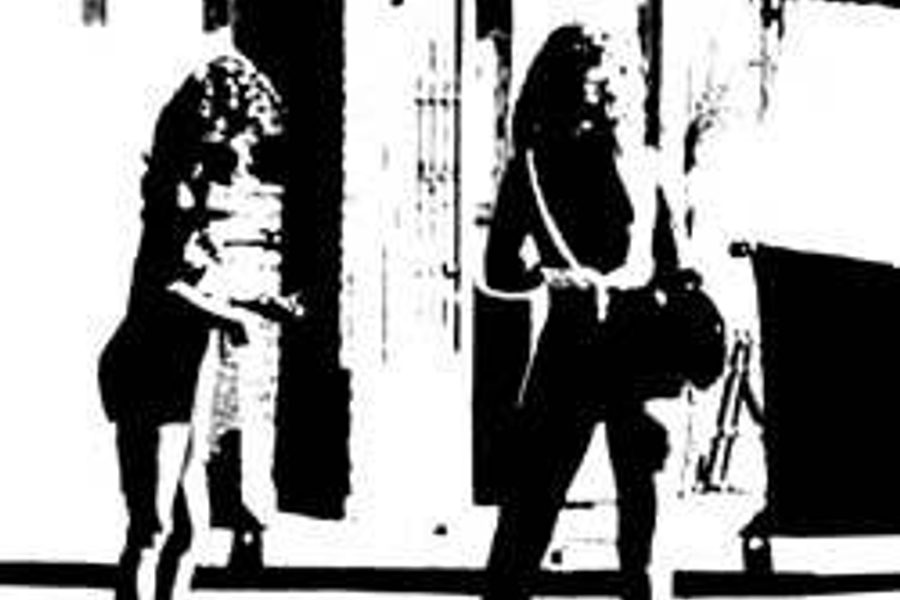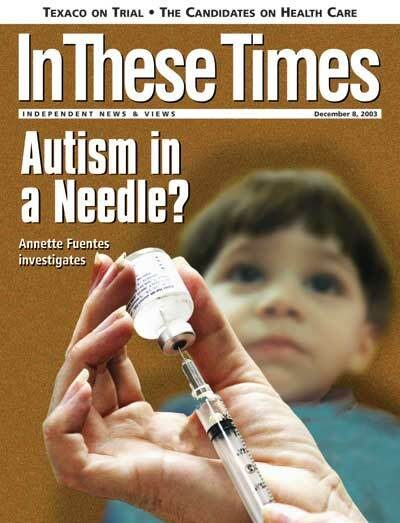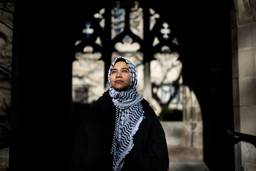
Growing up on Chicago’s South Side, Brenda Myers looked up to the prostitutes working outside her window. “I asked my grandmother what those women were doing. She said, ‘They take their panties off for money.’”
At age 9 this idea didn’t strike Myers as odd—a family member had been molesting her for years—and she grew up understanding that her body would be the way she got by: “I was thinking, well, they’re already taking my panties off, and I wasn’t getting any money. So I’ll make them pay for it,” she says.
She did, and like a majority of women working the streets, Myers became mired in a cycle of dependency on drugs, alcohol, prostitution and abusive relationships—a cycle that starts in youth and ends up landing them in jail and prison.
Women are the fastest growing segment of the incarcerated—more than 91,000 were in state and federal prisons in 2000 (a figure that does not include jails). While the number of incarcerated men grew by 77 percent between 1990 and 2000, the female population grew by 108 percent, according to U.S. Department of Justice statistics.
Like Myers, about half the women behind bars are there for nonviolent offenses, primarily prostitution- and drug-related violations and petty theft or fraud, according to the DOJ.
And like Myers, a significantly high number of them are victims of childhood sexual abuse. A recent study by the Chicago Coalition for the Homeless reported that 41 percent of women arrested for prostitution-related offenses in Cook County jail were sexually abused as children.
The Illinois Coalition Against Sexual Assault (ICASA) conducted a study in which 57 percent of women working as prostitutes in the state reported they were sexually abused as children. The study also found that more than 90 percent lost their virginity through assault, and 70 percent believed being sexually abused as children influenced their decision to become prostitutes.
Likewise, a 1995 study by the National Criminal Justice Reference Service found that people who were sexually abused as children are a whopping 27.7 times more likely than others to be arrested for prostitution.
As Myers describes, many prostitutes say they turned to paid dates as a way to take control of their sexuality after having had it taken from them. Others are forced into prostitution by their abusers—a 2001 study by the Center for Impact Research (CIR) noted that it is common for adults in particularly dire circumstances to force children into prostitution to pay rent or to buy drugs.
A number of women interviewed in Chicago tell similar stories of how they ended up in and out of jail on drug- and prostitution-related offenses. It starts with childhood sexual abuse by a relative or mother’s boyfriend, a lifelong psychological trauma for which they often never receive counseling or treatment. Growing up in households where substance abuse and prostitution are prevalent, the women started both at a young age. According to the CIR study, 62 percent of prostitutes have their first “date” before age 18.
“My mother’s ex-husband used to have me up in the middle of the night giving him head,” says Louise Lofton, another former prostitute in Chicago, who has worked with Myers to form a group called Exodus to help women leave prostitution.
“One time she came in unexpectedly, and he started beating her because he knew he was in the wrong; he wanted to cover up for himself,” Lofton says. “I ran into him once when I was in prostitution—I had this leopard print skirt on. I said, ‘This is because of you.’ He said, ‘I’m sorry.’ I said, ‘Fuck you.’”
Studies also show that almost all women working in prostitution use drugs and alcohol heavily. Many start using these substances or increase their usage in order to deal with the stress and emotional issues of the trade. Others begin to prostitute themselves to fund their drug habits or those of their partners or family members.
For many, the specter of sexual abuse lies behind it all—driving them to seek solace or release in drugs and sex and complicating attempts to change their lives and recover.
“The drug abuse is just one part of it,” says Tracy Banks-Geiger, the court and jail program coordinator at Genesis House, a free residential recovery program for women in prostitution in Chicago. “There are also issues of poverty, racism and childhood sexual abuse that never received any treatment.”
Women bear the brunt of prostitution incarcerations. Johns usually face heavy fines—under a Chicago city ordinance they are charged $700 in fines and car impoundment fees—but then, in the vast majority of cases, charges are dropped. Male pimps are likewise rarely arrested.
Along with this sexism, racism also plays in the challenges and threats faced by prostitutes. ICASA says that while 40 percent of street prostitutes are women of color, women of color constitute 55 percent of those arrested and 85 percent of those sentenced to jail time.
Dealing with sexual abuse and related traumas is key to breaking the cycle of incarceration and abuse. But most prisons and jails offer little in the way of support groups and counseling, and it can be even harder to access free resources once women get out.
In Chicago, several former prostitutes report that they were finally able to leave the lifestyle after finding support groups and programs that addressed both substance abuse and the physical and psychological issues involved in their early lives. Many women have had success at Genesis House, the only institution in the city accredited by the courts as an alternative to jail time. Genesis House is a strict yearlong residential program available free to walk-ins and women referred by the courts.
“They’re very gentle and patient with me and don’t rush me into anything,” says a 32-year-old Genesis House resident who asked that her name not be used. “They’re helping me build up all those things that had been ripped out of me by prostitution.”
In general, recovering prostitutes and service providers have a tricky balance to keep. They need to avoid stigmatizing or condemning prostitution as a lifestyle choice and female sexuality as a whole while still acknowledging that, for many, prostitution is a piece of a painful puzzle they want to leave behind.
To break the cycle of sexual abuse, prostitution, drugs and incarceration, many women note that there must be fundamental change in a society that allows or even encourages the exploitation of children and women.
“If it wasn’t for men you wouldn’t have prostitution,” Myers says. “They think it’s a joke, she’s having a ball. No she isn’t! They think they didn’t do anything wrong. Women need to be taught that their body isn’t an offering or a sacrifice.”
At age 9 this idea didn’t strike Myers as odd—a family member had been molesting her for years—and she grew up understanding that her body would be the way she got by: “I was thinking, well, they’re already taking my panties off, and I wasn’t getting any money. So I’ll make them pay for it,” she says.
She did, and like a majority of women working the streets, Myers became mired in a cycle of dependency on drugs, alcohol, prostitution and abusive relationships—a cycle that starts in youth and ends up landing them in jail and prison.
Women are the fastest growing segment of the incarcerated—more than 91,000 were in state and federal prisons in 2000 (a figure that does not include jails). While the number of incarcerated men grew by 77 percent between 1990 and 2000, the female population grew by 108 percent, according to U.S. Department of Justice statistics.
Like Myers, about half the women behind bars are there for nonviolent offenses, primarily prostitution- and drug-related violations and petty theft or fraud, according to the DOJ.
Childhood experiences loom large
And like Myers, a significantly high number of them are victims of childhood sexual abuse. A recent study by the Chicago Coalition for the Homeless reported that 41 percent of women arrested for prostitution-related offenses in Cook County jail were sexually abused as children.
The Illinois Coalition Against Sexual Assault (ICASA) conducted a study in which 57 percent of women working as prostitutes in the state reported they were sexually abused as children. The study also found that more than 90 percent lost their virginity through assault, and 70 percent believed being sexually abused as children influenced their decision to become prostitutes.
Likewise, a 1995 study by the National Criminal Justice Reference Service found that people who were sexually abused as children are a whopping 27.7 times more likely than others to be arrested for prostitution.
As Myers describes, many prostitutes say they turned to paid dates as a way to take control of their sexuality after having had it taken from them. Others are forced into prostitution by their abusers—a 2001 study by the Center for Impact Research (CIR) noted that it is common for adults in particularly dire circumstances to force children into prostitution to pay rent or to buy drugs.
A number of women interviewed in Chicago tell similar stories of how they ended up in and out of jail on drug- and prostitution-related offenses. It starts with childhood sexual abuse by a relative or mother’s boyfriend, a lifelong psychological trauma for which they often never receive counseling or treatment. Growing up in households where substance abuse and prostitution are prevalent, the women started both at a young age. According to the CIR study, 62 percent of prostitutes have their first “date” before age 18.
“My mother’s ex-husband used to have me up in the middle of the night giving him head,” says Louise Lofton, another former prostitute in Chicago, who has worked with Myers to form a group called Exodus to help women leave prostitution.
“One time she came in unexpectedly, and he started beating her because he knew he was in the wrong; he wanted to cover up for himself,” Lofton says. “I ran into him once when I was in prostitution—I had this leopard print skirt on. I said, ‘This is because of you.’ He said, ‘I’m sorry.’ I said, ‘Fuck you.’”
Untreated addictions
Studies also show that almost all women working in prostitution use drugs and alcohol heavily. Many start using these substances or increase their usage in order to deal with the stress and emotional issues of the trade. Others begin to prostitute themselves to fund their drug habits or those of their partners or family members.
For many, the specter of sexual abuse lies behind it all—driving them to seek solace or release in drugs and sex and complicating attempts to change their lives and recover.
“The drug abuse is just one part of it,” says Tracy Banks-Geiger, the court and jail program coordinator at Genesis House, a free residential recovery program for women in prostitution in Chicago. “There are also issues of poverty, racism and childhood sexual abuse that never received any treatment.”
Doing harder time
Women bear the brunt of prostitution incarcerations. Johns usually face heavy fines—under a Chicago city ordinance they are charged $700 in fines and car impoundment fees—but then, in the vast majority of cases, charges are dropped. Male pimps are likewise rarely arrested.
Along with this sexism, racism also plays in the challenges and threats faced by prostitutes. ICASA says that while 40 percent of street prostitutes are women of color, women of color constitute 55 percent of those arrested and 85 percent of those sentenced to jail time.
Dealing with sexual abuse and related traumas is key to breaking the cycle of incarceration and abuse. But most prisons and jails offer little in the way of support groups and counseling, and it can be even harder to access free resources once women get out.
Piecing together a life
In Chicago, several former prostitutes report that they were finally able to leave the lifestyle after finding support groups and programs that addressed both substance abuse and the physical and psychological issues involved in their early lives. Many women have had success at Genesis House, the only institution in the city accredited by the courts as an alternative to jail time. Genesis House is a strict yearlong residential program available free to walk-ins and women referred by the courts.
“They’re very gentle and patient with me and don’t rush me into anything,” says a 32-year-old Genesis House resident who asked that her name not be used. “They’re helping me build up all those things that had been ripped out of me by prostitution.”
In general, recovering prostitutes and service providers have a tricky balance to keep. They need to avoid stigmatizing or condemning prostitution as a lifestyle choice and female sexuality as a whole while still acknowledging that, for many, prostitution is a piece of a painful puzzle they want to leave behind.
To break the cycle of sexual abuse, prostitution, drugs and incarceration, many women note that there must be fundamental change in a society that allows or even encourages the exploitation of children and women.
“If it wasn’t for men you wouldn’t have prostitution,” Myers says. “They think it’s a joke, she’s having a ball. No she isn’t! They think they didn’t do anything wrong. Women need to be taught that their body isn’t an offering or a sacrifice.”
Kari Lydersen is a Chicago-based journalist, author and assistant professor at Northwestern University, where she leads the investigative specialization at the Medill School of Journalism, Media, Integrated Marketing Communications. Her books include Mayor 1%: Rahm Emanuel and the Rise of Chicago’s 99%.









